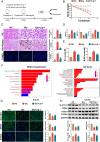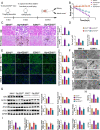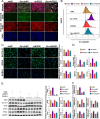The SOX4/EZH2/SLC7A11 signaling axis mediates ferroptosis in calcium oxalate crystal deposition-induced kidney injury
- PMID: 38169402
- PMCID: PMC10763321
- DOI: 10.1186/s12967-023-04793-1
The SOX4/EZH2/SLC7A11 signaling axis mediates ferroptosis in calcium oxalate crystal deposition-induced kidney injury
Abstract
Epigenetic regulation is reported to play a significant role in the pathogenesis of various kidney diseases, including renal cell carcinoma, acute kidney injury, renal fibrosis, diabetic nephropathy, and lupus nephritis. However, the role of epigenetic regulation in calcium oxalate (CaOx) crystal deposition-induced kidney injury remains unclear. Our study demonstrated that the upregulation of enhancer of zeste homolog 2 (EZH2)-mediated ferroptosis facilitates CaOx-induced kidney injury. CaOx crystal deposition promoted ferroptosis in vivo and in vitro. Usage of liproxstatin-1 (Lip-1), a ferroptosis inhibitor, mitigated CaOx-induced kidney damage. Single-nucleus RNA-sequencing, RNA-sequencing, immunohistochemical and western blotting analyses revealed that EZH2 was upregulated in kidney stone patients, kidney stone mice, and oxalate-stimulated HK-2 cells. Experiments involving in vivo EZH2 knockout, in vitro EZH2 knockdown, and in vivo GSK-126 (an EZH2 inhibitor) treatment confirmed the protective effects of EZH2 inhibition on kidney injury and ferroptosis. Mechanistically, the results of RNA-sequencing and chromatin immunoprecipitation assays demonstrated that EZH2 regulates ferroptosis by suppressing solute carrier family 7, member 11 (SLC7A11) expression through trimethylation of histone H3 lysine 27 (H3K27me3) modification. Additionally, SOX4 regulated ferroptosis by directly modulating EZH2 expression. Thus, this study demonstrated that SOX4 facilitates ferroptosis in CaOx-induced kidney injury through EZH2/H3K27me3-mediated suppression of SLC7A11.
Keywords: EZH2; Ferroptosis; Kidney injury; Kidney stones; SOX4.
© 2023. The Author(s).
Conflict of interest statement
The authors declare that there is no competing interests regarding the publication of this paper.
Figures







Similar articles
-
Luteolin alleviated calcium oxalate crystal induced kidney injury by inhibiting Nr4a1-mediated ferroptosis.Phytomedicine. 2025 Jan;136:156302. doi: 10.1016/j.phymed.2024.156302. Epub 2024 Nov 28. Phytomedicine. 2025. PMID: 39662099
-
p53 deacetylation alleviates calcium oxalate deposition-induced renal fibrosis by inhibiting ferroptosis.Biomed Pharmacother. 2023 Aug;164:114925. doi: 10.1016/j.biopha.2023.114925. Epub 2023 May 24. Biomed Pharmacother. 2023. PMID: 37236026
-
Ferrostatin‑1 alleviates oxalate‑induced renal tubular epithelial cell injury, fibrosis and calcium oxalate stone formation by inhibiting ferroptosis.Mol Med Rep. 2022 Aug;26(2):256. doi: 10.3892/mmr.2022.12772. Epub 2022 Jun 15. Mol Med Rep. 2022. PMID: 35703358 Free PMC article.
-
Ferroptosis, necroptosis, and pyroptosis in calcium oxalate crystal-induced kidney injury.Biochim Biophys Acta Mol Basis Dis. 2025 Jun;1871(5):167791. doi: 10.1016/j.bbadis.2025.167791. Epub 2025 Mar 13. Biochim Biophys Acta Mol Basis Dis. 2025. PMID: 40086520 Review.
-
Histone Methyltransferase EZH2: A Potential Therapeutic Target for Kidney Diseases.Front Physiol. 2021 Feb 18;12:640700. doi: 10.3389/fphys.2021.640700. eCollection 2021. Front Physiol. 2021. PMID: 33679454 Free PMC article. Review.
Cited by
-
Targeting ferroptosis: a new therapeutic opportunity for kidney diseases.Front Immunol. 2024 Jul 3;15:1435139. doi: 10.3389/fimmu.2024.1435139. eCollection 2024. Front Immunol. 2024. PMID: 39021564 Free PMC article. Review.
-
SOX4 accelerates intervertebral disc degeneration via EZH2/NRF2 pathway in response to mitochondrial ROS-dependent NLRP3 inflammasome activation in nucleus pulposus cells.J Transl Med. 2025 Apr 3;23(1):395. doi: 10.1186/s12967-024-05913-1. J Transl Med. 2025. PMID: 40181390 Free PMC article.
-
PRMT1-mediated methylation of UBE2m promoting calcium oxalate crystal-induced kidney injury by inhibiting fatty acid metabolism.Cell Death Dis. 2025 Jul 31;16(1):579. doi: 10.1038/s41419-025-07888-3. Cell Death Dis. 2025. PMID: 40744915 Free PMC article.
-
Development and Application of the CRISPR-dcas13d-eIF4G Translational Regulatory System to Inhibit Ferroptosis in Calcium Oxalate Crystal-Induced Kidney Injury.Adv Sci (Weinh). 2024 May;11(17):e2309234. doi: 10.1002/advs.202309234. Epub 2024 Feb 21. Adv Sci (Weinh). 2024. PMID: 38380498 Free PMC article.
-
EZH2 inhibition or genetic ablation suppresses cyst growth in autosomal dominant polycystic kidney disease.J Transl Med. 2024 Oct 29;22(1):979. doi: 10.1186/s12967-024-05785-5. J Transl Med. 2024. PMID: 39472935 Free PMC article.
References
Publication types
MeSH terms
Substances
Grants and funding
LinkOut - more resources
Full Text Sources
Medical

